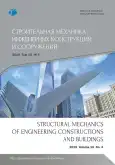Influence of the geometrical researches of surfaces of revolution and translation surfaces on design of unique structures
- Авторлар: Gbaguidi Aisse G.L.1
-
Мекемелер:
- University of Abomey-Calavi
- Шығарылым: Том 15, № 4 (2019)
- Беттер: 308-314
- Бөлім: Theory of thin elastic shells
- URL: https://journal-vniispk.ru/1815-5235/article/view/346283
- DOI: https://doi.org/10.22363/1815-5235-2019-15-4-308-314
- ID: 346283
Дәйексөз келтіру
Толық мәтін
Аннотация
Aims of research. The use, design and analysis of architectural and building structures in the form of smooth and composite surfaces have become relevant and in demand lately, which determined the purpose of this article - to analyze the use of analytical surfaces given vector, parametric or explicit equations in real structures. Methods. The relationship between studies on the geometry of surfaces of revolution and transport and the creation of new forms of thin-walled structures and buildings is determined. An example of a real structure is given on each surface. The article does not consider composite, multifaceted, fractal surfaces, as well as surfaces that are not defined analytically. Results. It turned out that only a small number of considered surfaces of these two classes have found application in the world. At the end of the article, a bibliography is presented, which sets out the mathematical side of the design of analytical surfaces, their computer modeling, more detailed information about real structures in the form of the surfaces under consideration.
Авторлар туралы
Gérard Gbaguidi Aisse
University of Abomey-Calavi
Хат алмасуға жауапты Автор.
Email: gbaguidi.gerard@yahoo.fr
Professor of Department of Civil Engineering; Director, Verechaguine A.K. Graduate School of Civil Engineering, Director of Laboratory of Materials and Structures (LAMS).
02 BP 244 Cotonou, Republic of BeninӘдебиет тізімі
- Krivoshapko S.N., Ivanov V.N. (2015). Encyclopaedia of Analytical Surfaces. Switzerland, Springer International Publishing, 752.
- Krivoshapko S.N., Mamieva I.A. (2018). Analiticheskie poverhnosti v arhitekture zdaniy, konstruktziy i izdeliy [Analytical surfaces in architecture of buildings, structures, and products]. Moscow: Librocom Publ., 328. (In Russ.)
- Mamieva I.A., Razin A.D. (2014). Parametrical architecture in Moscow. Architecture and construction of Russia, (6), 25-29. https://elibrary.ru/download/elibrary_ 21614483_18612954.pdf (In Russ.)
- Mamieva I.A. (2011). O klassifikacii analiticheskih poverhnostej [On classification of analytical surfaces]. International Scientific-and-Practical Conference “Engineering System - 2011”, Moscow, 63-65. (In Russ.)
- Krasic S. (2012). Geometrijske Površi u Arhitekturi. Gradevinsko-arhitektonski Fakultet, Univerzitet u Nišu, 238.
- Krivoshapko S.N. (2019). Optimal shells of revolution and main optimizations. Structural Mechanics of Engineering Constructions and Buildings, 15(3), 201-209. http:// dx.doi.org/ 10.22363/1815-5235-2019-15-3-201-209
- Mamieva I.A., Razin A.D. (2017). Landmark spatial structures in the form of conic surfaces. Industrial and Civil Engineering, (10), 5-11. (In Russ.)
- Krivoshapko S.N. (2002). Static, vibration, and buckling analyses and applications to one-sheet hyperboloidal shells of revolution. Applied Mechanics Reviews, 55(3), 241-270.
- Maan Jawad H. (2004). Design of Plate & Shell Structures. ASME Press, 476.
- Lewis M., Ove Arup. (1973). Roof cladding of the Sydney Opera. House Journal and Proceedings of the Royal Society of New South Wales, 106(1-2), 18-32.
- Brecher K. (2013). Mathematics, Art and Science of the Pseudosphere. Proceedings of Bridges 2013: Mathematics, Music, Art, Architecture, Culture, 469-472.
- Krivoshapko S.N., Ivanov V.N. (2018). Pseudospherical shells in building industry. Building and Reconstruction, 2(76), 32-40.
- Krivoshapko S.N. (2017). On application of parabolic shells of revolution in civil engineering in 2000-2017. Structural Mechanics of Engineering Constructions and Buildings, (4), 4-14. http://dx.doi.org/10.22363/1815-5235-20174-4-14
- Krivoshapko S.N., Ivanov V.N. (2018). Catenoidal shells. Industrial and Civil Engineering, (12), 7-13.
- Horta-Rangel J., Uehara-Guerrero H., Lopez-Lara T., Perez-Rea L., Hernandez-Zaragoza J. and Rojas-Gonzalez E. (2014). Optimal design of a fabric shell using a coupled femoptimization procedure. Asian Journal of Science and Technology, 5(11), 722-726.
- Rippmann M. (2016, February). Funicular Shell Design: geometric approaches to form finding and fabrication of discrete funicular structures. (Doctoral Thesis, ETH Zürich). 308. doi: 10.3929/ethz-a-010656780
- Rippmann M., Block Ph. (2013). Funicular shell design exploration. ACADIA 13: Adaptive Architecture: Proceedings of the 33rd Annual Conference of the Association for Computer Aided Design in Architecture (ACADIA), Cambridge, 24-26 October, 337-346.
- Krivoshapko S.N., Gil-oulbe M. (2013). Geometry and Strength of a Shell of Velaroidal Type on Annulus Plan with Two Families of Sinusoids. International Journal of Soft Computing and Engineering (IJSCE), 3(3), 71-73.
- Gogoberidze Ya.A. (1950). Covers “Darbazi”. Tbilisi: Tehnika da shroma Publ., 278.
- Mamieva I.A. (2019). Influence of the geometrical researches of ruled surfaces on design of unique structures. Structural Mechanics of Engineering Constructions and Buildings, 15(4), 299-307.
- Mihailov B.K., Guriyanov K.V. (1983). Stress state of shells of revolution (reviews of works devoted to linear theory of shells of revolution during the last 10 years). Leningrad: LISI, 28.
- Mazurkiewicz Z.E., Nagorski R.R. (1990). Shells of revolution. Amsterdam, Elsevier Science Publishers, 640.
- Zingoni Alphose. (2017). Shell Structures in Civil and Mechanical Engineering: Theory and Analysis. 2nd ed. Thomas Telford Limited, 438.
Қосымша файлдар









